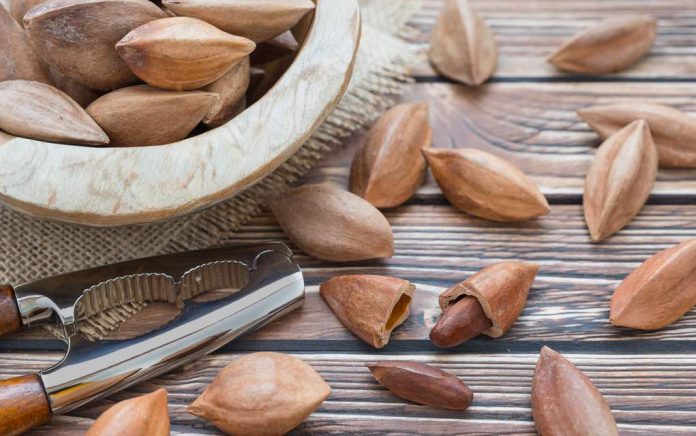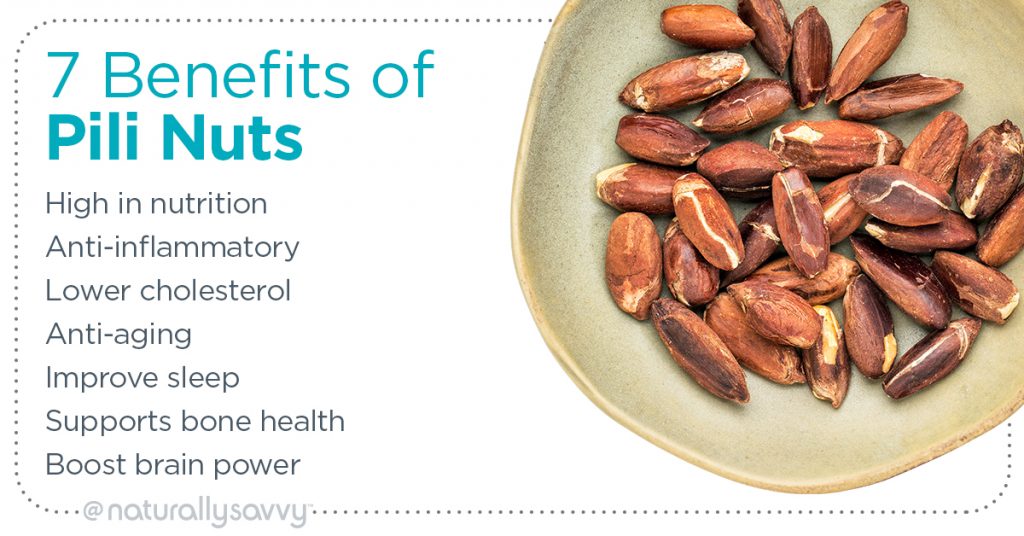
If you’re crazy about nuts, if you like to try new foods, or if you are on the lookout for a new nutrient-dense superfood, then let’s welcome to the stage–pili nuts! Of course, they aren't really new, since the people where they're grown have known about them for centuries. But the pili nut is gradually poking its head out of its shell in its native turf and becoming known in the Americas and Europe.
Read just a handful of nuts a day can reduce your cancer and heart disease risk
What is a pili nut?
The pili nut (Canarium ovatum), which is also known as kenari, is the product of a tropical evergreen tree. The tear-shaped nuts are about 1.6 to 2.8 inches long, and each end of the nut is pointed, one being less pointy than the other. The outer shell is light brown to tan while the inner nut or kernel is milky in color underneath a brownish seed coat. Each kernel is composed of approximately 8 percent carbohydrate, 11.5 to 13.9 percent protein, and 70 percent fat.
How are pili nuts grown and used?
Pili nut trees are found throughout Malaysia, Indonesia, and the Philippines, and the nuts are harvested from natural strands of the trees in the mountains. The nuts are popular for their taste and nutrition as well as their oil, which can be used for making soaps and cosmetics.
People in Southeast Asia enjoy pili nuts in a variety of ways. Perhaps the most popular way is as a deep-fried, sugar-coated dessert, and as candy and brittle. In Indonesia, they are used in cakes and other baked goods, chocolate, and ice cream. Pili nuts are exported to Taiwan and Hong Kong and are a key ingredient in the famous Chinese festive moon cakes.
What do the nuts taste like?
Raw pili nuts are said to taste similar to sunflower seeds, while others say they are closer to macadamia nuts or even a combination of all types of nuts together. When you roast them, they have a chewy exterior and a buttery interior.
What are the health benefits?
People in North American are just beginning to discover the health benefits of pili nuts. If you are on a keto diet, then you’ll love pilis because they are high in fat and low in carbs. Here are some other benefits you should know.
High in nutrition. Like other nuts, pili nuts are high in calories, coming in about 650 calories per cup. However, eating just a few of these nutrient-dense nuts slowly will satisfy your hunger and give you a nutrition boost as well. In fact, pili nuts contain the most magnesium of all nuts! A single serving completes your daily dose of copper and manganese as well. Pili nuts also reportedly are a complete protein, which means they contain all of the essential amino acids you need.
Anti-inflammatory powers. There’s a lot of focus on the impact of inflammation on health today, and these nuts are up to the challenge. Pilis contain many antioxidant compounds, including vitamin E, to fight inflammation at all levels in the body.
Can lower cholesterol. Pili nuts are a good source of omega-3 fatty acids (yes, the healthy fat found in fish). Omega-3s are helpful in balancing cholesterol levels, especially lowering the bad cholesterol (LDL). This makes these nuts a good choice for heart health, diabetes, and weight loss.
Aid in anti-aging. The potent antioxidants in pili nuts are your friends when it comes to anti-aging powers. Including these tasty morsels in your diet can help fight free radicals that promote wrinkles and other signs of aging.
Promote better sleep. Magnesium is a mineral known for its ability to support sleep and the release of relaxing hormones. Since pili nuts have the highest amount of magnesium of all nuts, enjoying a few before retiring could help with sleep.
Support bone health. Your bones needs more than calcium to stay strong, and pili nuts provide several of those bone-supporting nutrients. Along with calcium, these nuts provide manganese, magnesium, and phosphorus, all necessary for bone strength.
Boost brain power. Pili nuts contain omega-3 fatty acids, which have been shown to help with improving cognitive functions in the brain, including learning, concentration, awareness, and memory. Omega-3s also appear to be helpful in offering some protection against neurodegeneration associated with Alzheimer’s disease and other forms of dementia.
Where can I get pili nuts?
Although you may not see pili nuts on the shelves next to the walnuts and macadamia nuts in most stores, they are beginning to make their presence known in a few large retailers. Another purchase option is online sales through Amazon.
A big reason for their scarcity is that they are currently exported from one place only—the Philippines. Gathering these tasty morsels also is very labor intensive because they are harvested and shucked by hand, and they are very hard nuts to crack!
Bottom line
If you’re nuts about nuts and looking for a delicious (and a little exotic) way to boost your overall nutritional intake, then it may be time to give pili nuts a try. Enjoy them like you would any other nut—as a snack, a topping, and in baked goods, smoothies, and casseroles. Yum!
Sources
Congdon M. Pili nuts are the new superfood nut you’re going to love. Shape 2019 May 5
Dyall SC. Long-chain omega-3 fatty acids and the brain: a review of the independent and shared effects of EPA, DPA and DHA. Frontiers in Aging Neuroscience 2015; 7:52
The Pili Hunters. 6 health benefits of pili nuts.
The Pili Hunters. The pili nut
Staughton J. 15 incredible foods for a healthy heart. Organic Facts. 2019 Sep 24











